Table of Contents
- Watts, Volts and Amps
- The Most Powerful Dynamo USB Chargers
- Dynamo Hub Drag
- Power Banks & Charging Batteries
- 20-Minute Charging Test
- The Neatest Dynamo USB Charging Systems
- Testing Your USB Charger
- The Best-Performing Dynamo USB Chargers
- Creating Bombproof Dynamo USB Chargers
- List Of Different Dynamo USB Chargers
- Summary
There is a wide array of dynamo USB chargers available (24 of ’em, in fact), and while most do an adequate job of keeping your electronics charged at high speeds, there is only a select few which can provide a decent charge at ‘touring’ speeds.
Dynamo USB charger technology is actually improving at an incredibly fast rate. Very small companies (ie. often just one person) are designing both hardware and software that exploits the very modest power offered by a dynamo hub. The result is powerful USB chargers that offer high levels of efficiency, that can be neatly fitted to any bike.
This is a pretty technical resource, so strap yourselves in and take it slow. A big focus will be the power output of different chargers at different speeds, but we’ll also look at dynamo hub drag, charger efficiency, form factor and how quickly you can expect your batteries to charge.
This article was originally written September 2017 but has been re-written in July 2019 with the latest information.

Watts, Volts and Amps
Firstly, let’s quickly cover a few basic electricity units of measurement. It’ll take a moment to get your head around this, but the knowledge will help, promise!
Today we’ll be discussing voltage (in volts or ‘V’) and current (in amps, or ‘A’). A common analogy for these units of measurement is in terms of a water pipe. Voltage is the water pressure and current is the flow rate. By increasing the water pressure in a pipe, you will increase the flow rate too. It’s the same with electrical systems; increasing the voltage increases the current.
Watts (W) is the total electrical system power, equal to the voltage (V) multiplied by the current (A). The equation is, therefore:
Watts (W) = Volts (V) x Amps (A).
A 3-watt dynamo hub will put out 6 volts at 0.5 amps (3W = 6V x 0.5A) in AC power. Once the power is converted to DC it’s more like 5V and 0.5A, which is the power required for USB charging. While some USB chargers will start charging at lower rates of power, most devices like to charge above 2-watts (5V x 0.4A) to ensure the charging level is stable.
2-watts can be reached by the best dynamo USB chargers at speeds between 11-13kph. If you’re cycling at lower speeds for short periods of time, a buffer battery will need to be incorporated into your charging system to help meet the power needs of your device. And when cycling for long periods of time below 11-13kph, you’ll need to look to other charging solutions (solar or power banks are usually best for off-road bikepacking).
Most dynamo USB chargers use chipsets with a current limit to prevent overheating (eg. Sinewave Revolution is 1A, therefore the maximum power is about 5W (5V x 1A)). It can be said that any USB charger that puts out high watts will also be putting out a high current.
The Most Powerful Dynamo USB Chargers
Fahrrad Zukunft has conducted some very extensive testing over the years that determines the amount of power (in watts) that can be produced by various dynamo USB chargers. The three below charts (2016, 2016 and 2019) compare 13 different models.
To put the below numbers in perspective, consider that a smartphone consumes around 3-4 watts in navigation mode with full-screen brightness. Therefore, just to keep the battery at the same level will require cycling speeds of 15 to 25kph depending on the model of USB charger. Even then, there’s only a handful of products that generate enough power for this activity.
Let’s take a look at the numbers.

The graphs above show the output power at the USB port at various cycling speeds. You’ll notice that most power curves are rather linear from 5kph until they plateau somewhere between 20-40kph. The exception is the Forumslader V5, which uses a special series of capacitors to boost the power potential of a dynamo hub at low speeds.
Power at different speeds:
1 Watt – Most chargers will hit 1w between 7-10kph.
2 Watts – At 11kph the highest performing charger hits 2w (Plug5 Plus). Most other chargers will hit 2w between 12-15kph
3 Watts – At 14kph the highest performing charger hits 3w (Plug5 Plus). Other chargers hit 3w between 15-25kph
4 Watts – At 17kph the highest performing charger hits 4w (Plug5 Plus) – Other chargers hit 4w between 27-28kph
5 Watts – At 20kph the highest performing charger hits 5w (Forumslader) – Some chargers hit 5w above 35kph
The top-performing chargers:
Cinq Plug5 Plus – 2w@11kph, 3.5w@15kph, 4.5w@20kph, 5w@25kph – Best for sub-20kph speeds
Forumslader V5 – 2w@12kph, 3w@15kph, 4.75w@20kph, 6.5w@25kph – Best for above-20kph speeds
Lumi-Con P5 – 2w@12kph, 3w@15kph, 4w@20kph, 4.25w@25kph
Dynamo Harvester Plus – 2w@14kph, 2.5w@15kph, 4.5w@20kph, 6.25w@25kph
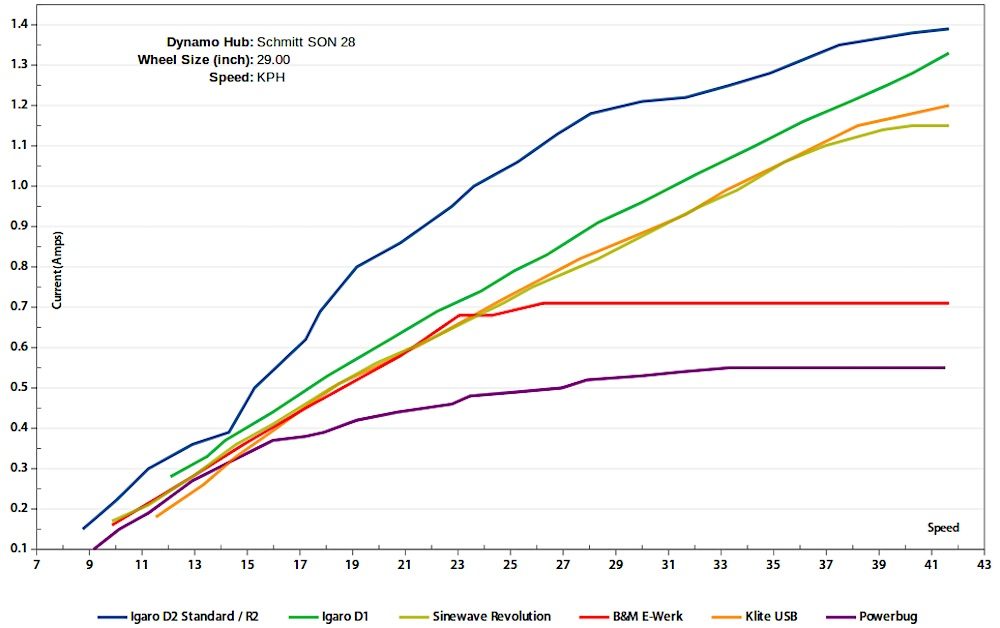
Igaro has recently published some non-independent results for a few missing chargers. These numbers don’t perfectly align with Fahrrad Zukunft, but they are within 10% when examining the Sinewave Revolution. The x-axis is measured in amps, but we can use the equation to convert amps to watts by multiplying by 5 (volts).
Here are some quick conversions:
10kph – Igaro D2 (1.1w), E-Werk (0.9w), Sinewave (0.9w)
15kph – Igaro D2 (2.5w), Igaro D1 (2w), kLite (1.75w), Sinewave (1.75w), E-Werk (1.75w)
20kph – Igaro D2 (4w), Igaro D1 (3w), kLite (2.75w), Sinewave (2.75w), E-Werk (2.75w)
25kph – Igaro D2 (5.2w), Igaro D1 (3.75w), kLite (3.5w), Sinewave (3.5w), E-Werk (3.5w)
30kph – Igaro D2 (6w), Igaro D1 (4.75w), kLite (4.5w), Sinewave (4.5w), E-Werk (3.5w)
Dynamo Hub Drag
There is no such thing as free energy! Do you want a powerful charging system? Ok, well you’re going to have to pedal a bit harder for it. Let’s take a look at dynamo hub ‘drag’ from using different charging systems.

The charts above show the power created at the dynamo hub by different USB chargers. The efficiency of a high-quality dynamo hub at low power (eg. cycling at 10-20kph) works out to be around 50-60%. This means that when the charger is making between 1-3 watts you can roughly double that figure to work out the drag (in watts) at the hub.
Therefore, when making 2.5 watts for USB charging, you’re using about 5 watts of your pedalling power. That drag equates to ~0.4kph slower riding speeds than if you weren’t charging (80kg rider / 15kg bike and gear / 150 watts / flat road). Or a ~3-minute time penalty over a 100km ride.
The efficiency increases to 70-80% at high power (ie. cycling at 30kph). This means that a charger like the Forumslader V5 will be taking 15-watts from your pedalling power while charging at 10.5 watts. That drag equates to ~1.1kph slower riding speeds than if you weren’t charging at 10.5 watts (80kg rider / 15kg bike and gear / 150 watts / flat road). Or a ~9-minute time penalty over a 100km ride.
That’s a decent chunk of time, so it’s in the best interests of charger manufacturers to make efficient units that don’t create too much power, or the drag becomes particularly noticeable when riding.
Power Banks & Charging Batteries
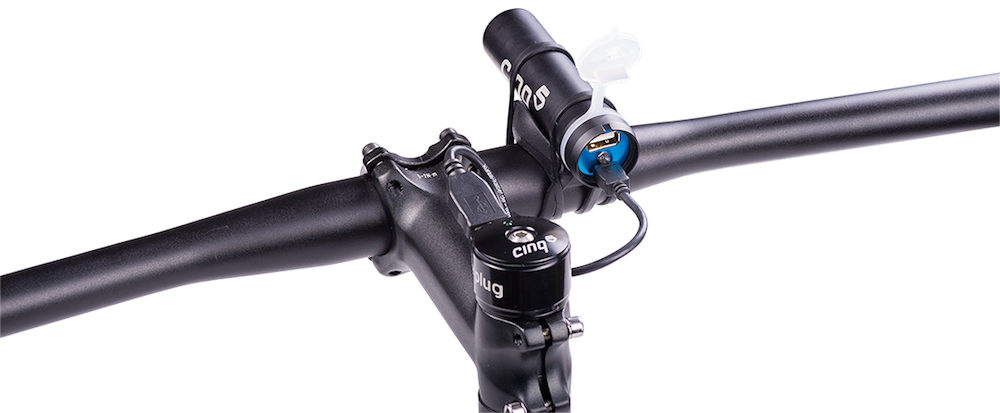
Once you drop below around 2-watts, a dynamo charger will not be able to provide power to most devices. But luckily, some chargers have integrated buffer batteries that will swoop in and provide the power needed for low-speed riding. For this feature, check out the Cinq Plug5 Plus, NC-17 Appcon 3000, Lumicon P5, Forumslader V5 and B&M USB-Werk.
Charging Batteries or Power Banks
If your speed is regularly dropping above and below 11-13kph, it’s best to charge into a power bank for later use. But this is not the most efficient way to keep your devices charged because there are energy losses in the additional circuitry. When power is stored in a battery, it experiences a storage loss of around 15-20%. This means you lose around 1-hour of power generation per 5-hour ride, which adds up!
If you’re cycling faster than 11-13kph, make sure to minimise this loss in efficiency by charging your electronics either straight from the USB charger or by using batteries with a ‘pass-through’ feature (the Cinq Smart Power Pack is the best available).
How Long Does It Take To Charge A Battery?
This depends on the dynamo USB charger and your cycling speed. Let’s take a look at two different power outputs.
Example One: 2.5-Watts (12.5kph on the Cinq Plug5 Plus)
Once a 3-watt dynamo hub has been converted from AC to DC the output will translate to roughly 5V and 0.5A, which for an hour of riding is 500mAh. Charging a 5000mAh battery will, therefore, equate to 10 hours of riding. However, when we factor in the small losses in the charging circuitry, we lose around 20% of the total generated power. Adding the 20% extra ride time (10 hours + (10 hours x 0.2)) and we’re looking at 12 hours of riding to fill the battery from scratch.
Example Two: 4-Watts (17kph on the Cinq Plug5 Plus)
If we use fancy circuitry to boost the output power to 4-watts (5V and 0.8A), we can fill a 5000mAh battery in 6.25 hours of riding. When we account for the ~20% losses in the charging circuitry, this results in 7.5 hours of riding to theoretically fill the battery from scratch.
You can usually find out the battery size of your USB device in the product specifications or written on the battery itself. Read more about power banks and buffer batteries in my resource HERE.
20-Minute Charging Test
While the graphs above give us an idea of the power output at specific speeds, in the hills, it is unusual to cycle at a constant speed for long periods of time. To help simulate hilly or undulating riding conditions, Fahrrad Zukunft created a dynamic test with varied cycling speeds to see which dynamo USB chargers could generate the most power. The test is probably a little over the top in speed variation, but it’s still pretty interesting to see the losses in the charging circuitry.
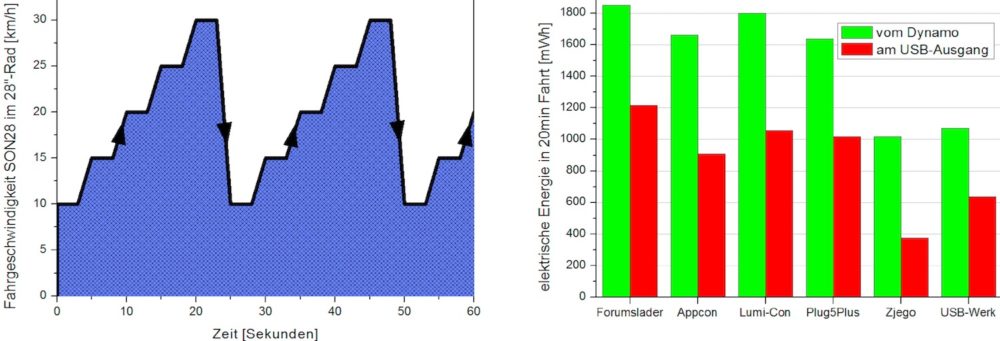
The test changed the cycling speed in 2-second steps from 10kph up to 30kph and then back down to 10kph again. The accelerations between steps took 3-seconds. This 20-minute test essentially exposes the responsiveness of the microcontrollers inside the chargers, which are constantly trying to optimise the output power at different cycling speeds.
Output power at the USB port after 20 minutes:
1. Forumslader V5 (1200mWh or 240mAh)
2. Lumi Con P5 (1000mWh or 200mAh)
3. Plug5 Plus (1000mWh or 200mAh)
4. NC-17 Appcon 3000 (900mWh or 180mAh)
5. USB Werk (600mWh or 120mAh)
6. Zjego (400mWh or 80mAh)
The test also shows differences in charging efficiency. The bigger the difference between the mWa at the dynamo hub and USB port, the more inefficient the charging system. For example, the Zjego turns 1000mWa into only 400mWa in this test, indicating some very big losses in the circuitry (~40% of power retained). On the other hand, the Forumslader V5 retained ~66% of the power created.
Tying this back to battery charging in the previous section, we could expect the Forumslader V5 to charge a 5000mAh battery in 8.33 hours (including losses in the battery circuitry). The Plug5 Plus would take 10 hours. The USB-Werk would take 16.65 hours.
The Neatest Dynamo USB Charging Systems
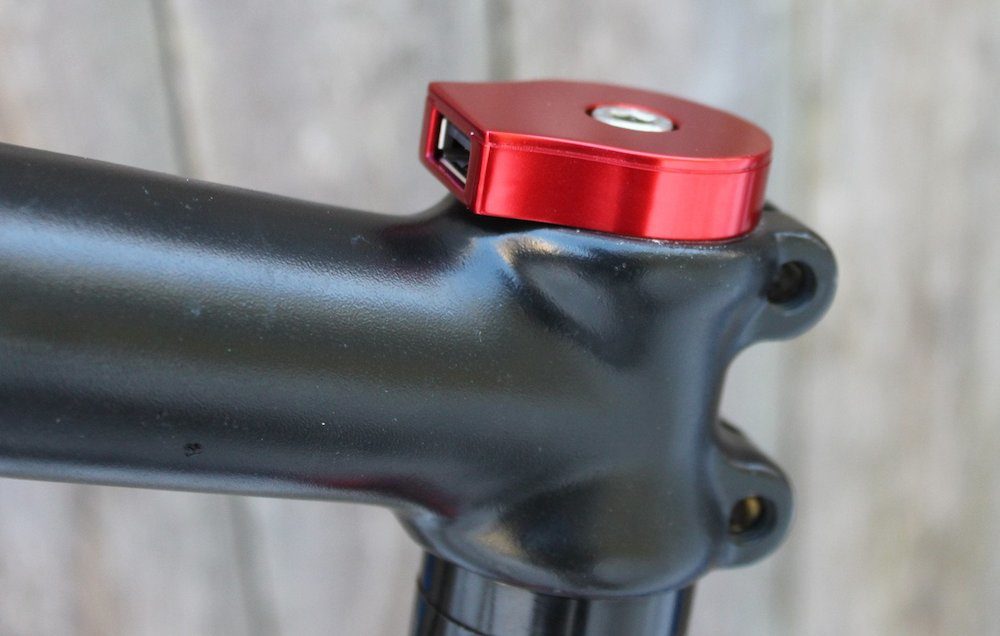
Steerer Tube USB Chargers
I don’t know about you, but I really appreciate a neat and integrated charging solution – and the steerer tube mounted systems have got to be the best in this regard. I personally use the Plug5 Plus which integrates a 1100mAh buffer battery inside the steerer for cycling at speeds below 11kph. A very neat metal ring seals the USB-C port from the elements when needed.
Check out the Cinq Plug5 Plus, Forumslader V5 Aheadring, Sinewave Reactor and Cycle2Charge V2.
Regular USB Chargers
Ortlieb has a handlebar bag called the Ultimate 6 Pro E which has connectors built into handlebar bag mount. This allows you to keep your USB charger and devices inside your waterproof bag, and take the handlebar bag off without unplugging anything. That just leaves a few wires on your bike – a very neat solution!
Dynamo Light USB Chargers
Here’s another super neat charger design. There are a handful of lights that also incorporate the circuitry for charging USB devices. This creates a very neat (less cabling) and often cost-effective light+charger. That said, some light/chargers are less efficient than standalone units because they are not optimised around charging.
Check out the Sinewave Beacon, Forumslader IQ-X, Axa Luxx70 Plus and B&M Lumotec IQ2 Luxos.
Testing Your USB Charger

If you’re having issues with charging, a cheap USB LCD Voltmeter can help diagnose whether your USB charger is making the right amount of power. If you’ve determined you’re getting the right voltage and current for your device, you may be having issues with the particular cache battery you’re using.
The Best-Performing Dynamo USB Chargers

Cinq Plug5 Plus // Sub-20kph
Most bike travel is conducted at speeds below 20kph (12mph), and the charger that offers the most power at these speeds is the Plug5. Not only is it powerful, but it also integrates a buffer battery into the system for the times you’re cycling below 11kph. The covered USB port is very neat too!
Cinq Plug5 Plus Numbers:
2w @ 11kph
3.5w @ 15kph
4.5w @ 20kph
5w @ 25kph
Forumslader V5 // Above-20kph
The Forumslader V5 uses a special series of capacitors to achieve big power from 20 to 30kph (12-19mph) in particular. It also incorporates buffer batteries (3x700mAh) and a neat USB port near the handlebars.
Forumslader V5 Numbers:
2w @ 12kph
3w @ 15kph
4.75w @ 20kph
6.5w @ 25kph
Creating Bombproof Dynamo USB Chargers
Kerry from kLite focuses on building dynamo light and charging systems for remote backcountry use. His main aim is reliability, so his charging systems are as simple as possible, using thick internal cabling, full waterproofing and smoothing capacitors that offer ultra-consistent waveforms (best practice for direct charging; Kerry says they take up half of his charger).
Usually, more complex circuitry and small form factors result in more chance of something going wrong, so it’s always best to hunt around for reviews online to see how different USB chargers are performing in the world’s harshest environments.
List Of Different Dynamo USB Chargers
You can see a list of most hub dynamo USB chargers options HERE.
Summary
The top-tier dynamo USB chargers offer very decent power these days, provided your touring speed is above 11-13kph. Once you hit 15kph with five of the charging units tested, you’ll be generating more than 3-watts which is a very decent charge for most batteries and devices. And by 17-20kph you can generate 4-watts for even the most power-intensive smartphones.
You can neatly integrate a USB charger into your steerer tube, front dynamo light or handlebar bag via the Ortlieb Ultimate 6E connectors. There are lots of great options!
Remember that you increase the dynamo hub drag when generating additional power, but this will be necessary if you’re a heavy electronics user (eg. smartphone navigation with the screen always on). That said, if you just want to keep on top of your phone or GPS, almost all USB chargers will do this job just fine.
Learn About Dynamo Hub Systems HERE, About Buffer Batteries HERE and Dynamo Lights HERE


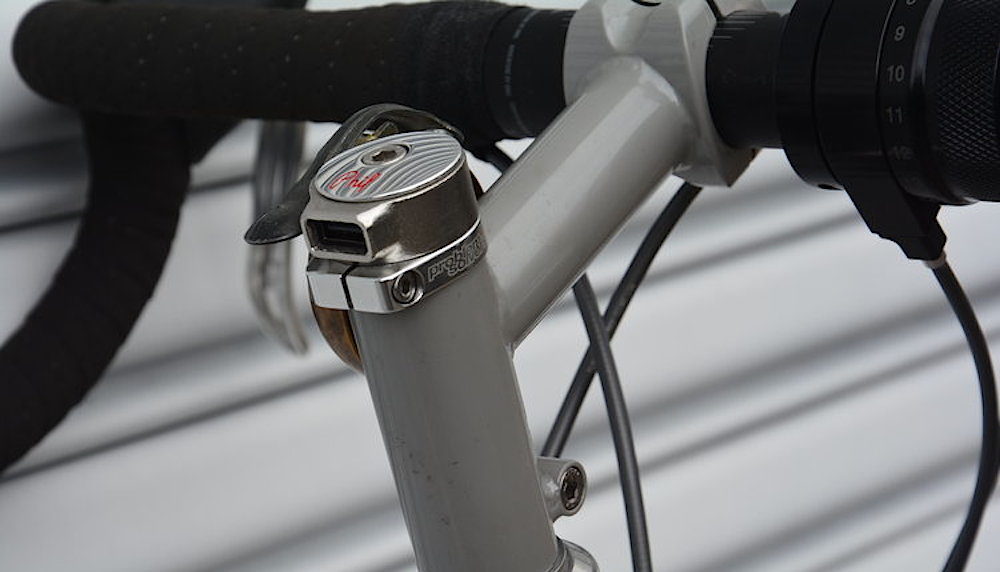
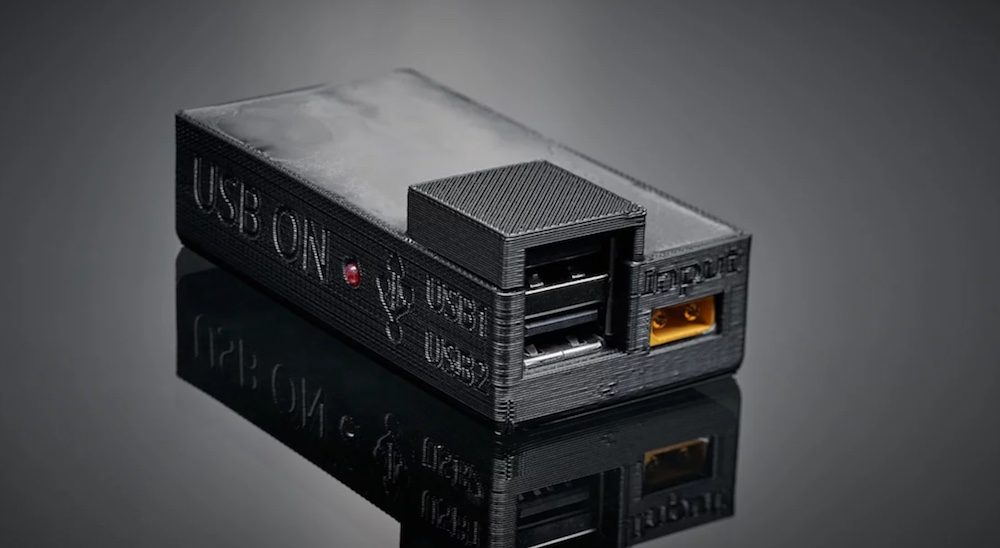
Thanks Alee 🙂 does the hub add drag all the time or only when powering a light or battery?
The drag is very low when there is nothing drawing power: https://www.cyclingabout.com/dynamo-hub-drag-lab-testing/
e-werk is crap. wouldn’t recommend it to anyone. get sinewave
Resistance as you are using it is a very poor choice, especially with electrical in front of it. You mean it similarly to air resistance, so a much less confusing choice would be input power, or to be even clearer, mechanical input power. Hub drag as Simon and you discuss is also a better choice, but drag typically implies completely lost power, which this is not.
Noted! I’m trying to keep it all as easy as possible to understand in a practical sense, so might go with hub drag.
I would be nervous charging an expensive mobile directly from the dynamo and I have never seen any tests of the output voltage(including spikes) of any of these 5V USB charging devices. Did You test this?
Fahrrad Zukunft conducted the testing. I’ve never had an issue running my iPhone directly from my Plug III, but if you are concerned, you can always add in a cache battery to your dynamo charging system.
Any thoughts about charging from a dynamo built in to a small (16″ iso 305) wheel? We’re planning on doing our charging from a Bob trailer’s wheel.